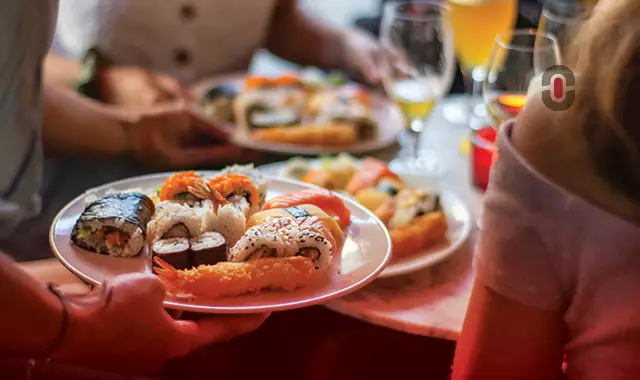In the global business environment, food often plays a central role when you try to build relationships, facilitate discussions, and master different (and why not difficult) situations. The perception of food, including taste preferences and dining etiquette, varies widely across cultures, and understanding these nuances is essential for successful cross-cultural interactions. Food is more than just sustenance; it is a reflection of cultural identity and values. In business settings, meals are often used to make a good start, celebrate deals, or develop mutual trust. The more knowledgeable you are about local food customs and preferences, the more enhanced your credibility and respect for your hosts could be.
This is the second article from the new “Translating Taste” series. You can enjoy the first one here.
Cultural Significance of Food in Asia
Food in Asia is much more than just livelihood; Asian food culture is a profound expression of identity, social structure, and spiritual beliefs. Each region in Asia has developed its own unique culinary traditions, often rooted in historical, geographical, and religious influences. The cultural significance of food in Asia can be seen in various aspects, such as communal eating, religious rituals, festivals, and daily practices.
Dining etiquette in Asian countries and cultural differences in food perception vary significantly across countries and cultures, each with their own set of rules and customs that reflect deep-rooted values and traditions. Whether using chopsticks correctly, understanding the importance of communal dishes, or recognizing the symbolism of certain practices, observing these etiquettes and food rituals is very important in a business setting. On the other hand, not only translating the taste, but also the literal translation – of language, and the inclusion of а professional translation service in your business strategy could easily lead to successful business relationships in Asia. What’s discussed in this article may be of help.
Etiquette for Dining With Clients in Asia – Examples
In Japan, you should avoid pointing chopsticks at others and should not stick them upright in a bowl of rice, as it resembles a funeral ritual. As far as drinking is concerned, it is polite to wait for everyone to be served before drinking. Also, when pouring drinks for others, you’d better hold the bottle with both hands. It is polite to refill others’ drinks before your own.
In China, when toasting, it is polite to ensure your glass is lower than the person you are toasting with, as a sign of respect. Also, the seating arrangement is often based on hierarchy. The guest of honor typically sits facing the entrance.
In South Korea, it is common to wait for the oldest person to start eating before you begin. And when drinking, it is polite to turn your head away from elders and cover your mouth.
Understanding Taste Preferences and Cultural Sensitivity in Business Dining
Asia is the home of a myriad of culinary traditions, each with its own distinct taste preferences and flavor profiles. The continent’s diverse geography, climates, and cultural histories contribute to the variety of tastes found across different regions.
In China, three of the basic eight cuisines are Sichuan, Cantonese, and Shandong. Known for its bold, spicy flavors, Sichuan cuisine features generous use of chili peppers, garlic, and the unique numbing sensation of Sichuan peppercorns. Dishes like mapo tofu (tofu in a spicy sauce, along with minced meat) and kung pao chicken (spicy, stir-fried cubes of chicken plus peanuts, vegetables, chili peppers and Sichuan peppercorns) exemplify this fiery style. Cantonese cuisine favors lighter, fresher flavors, and often involves steaming, stir-frying, and braising, in order to preserve the natural taste of ingredients. Dim sum (small dishes for brunch), roasted meats, and delicate soups are staples. Shandong cuisine emphasizes savory and rich flavors, and includes dishes such as braised meats and seafood stews, often seasoned with vinegar and garlic.
Japanese cuisine is renowned for its umami, a savory taste found in ingredients like soy sauce, miso, seaweed, and mushrooms. Dashi, a broth made from kelp and bonito flakes, is a cornerstone of many dishes. Sushi, sashimi, and tempura are classic examples where the umami taste is highlighted. The flavors are subtle and the seasoning is minimal.
In South Korea, fermented foods are fundamental. Kimchi, a fermented vegetable dish, is served at almost every meal. Fermented soybean products like doenjang (soybean paste) and gochujang (chili paste) are used to add umami and depth to dishes.
In India, you should be aware of dietary restrictions based on religious beliefs, such as vegetarianism or avoidance of beef and pork. The right hand is used for eating, as the left hand is considered unclean. It’s very common to invite others to take more food or drink, by saying “please”, “thank you”, and other magic words.
Navigating Alcohol and Beverages
 In Japan, sake (rice wine) and beer are commonly served during business meals. It is respectful to match the drinking pace of your senior or host, as refusing a drink may be seen as impolite. Also, what’s known as nomikai culture – which literally means “meeting to drink” – is prevalent in business. The objective is to build up serious social capital with the boss and bond with the rest of the crew. Another point of etiquette which differs from Western business culture is that it is considered acceptable to become drunk at nomikai. In the same fashion, things said and done under such circumstances are not taken seriously, and are forgiven or ignored upon return to the workplace.
In Japan, sake (rice wine) and beer are commonly served during business meals. It is respectful to match the drinking pace of your senior or host, as refusing a drink may be seen as impolite. Also, what’s known as nomikai culture – which literally means “meeting to drink” – is prevalent in business. The objective is to build up serious social capital with the boss and bond with the rest of the crew. Another point of etiquette which differs from Western business culture is that it is considered acceptable to become drunk at nomikai. In the same fashion, things said and done under such circumstances are not taken seriously, and are forgiven or ignored upon return to the workplace.
In China, baijiu, a strong distilled spirit, is often served at business dinners. Toasts are an integral part of Chinese business dining culture. The host typically offers the first toast, often to health, success, or prosperity. After the initial toast, guests may propose their own toasts, often individually to each person at the table. It is acceptable to decline further drinking by placing your hand over your glass or leaving it full.
In South Korea, soju, a clear distilled spirit, is the most popular drink for business meetings. Makgeolli, a milky rice wine, is also commonly enjoyed. Drinking sessions, known as hoesik, are a key part of South Korean business culture, often extending into late-night socializing. Similar to Japan, it is customary to pour drinks for others. You should ensure that everyone’s glass is refilled before your own, and use both hands when pouring.
Case Studies and Practical Examples
A business dinner in South Korea may start in a restaurant, then relocate to an ice cream store or café, then a bar and then karaoke (noraebang), which is extremely popular there.
Fruits are very expensive in Japan and South Korea, and big fruit baskets are an old tradition, especially in business contexts.
Food is so important in Asia, that the casual form of asking of “How are you?” in Korean, bap meogeosseoyo, means “Have you eaten?” or “Have you eaten rice?”, when literally translated.
The taste and taboos of the guests should be considered, when ordering dishes in China. Buddhists eat vegetarian food, and Taoists do not eat beef. It is necessary to pay attention to the combination of meat and vegetables, hot and cold, and balanced nutrition. Business banquets usually choose Cantonese cuisine instead of the spicy Sichuan cuisine, which is more popular among young people.
After dinner, Chinese people usually have another round, and compared to karaoke, which has become a little unpopular in China in recent years, more people will go for a bath or massage afterwards.
Conclusion
Mastering the art of business dining etiquette in Asia is an essential skill for any business professional looking to succeed in the region. It requires patience, observation, and willingness to learn and adapt. By doing so, you not only honor the rich cultural heritage of your hosts, but also pave the way for successful and harmonious business relationships. Whether you are toasting a new partnership in China, sharing a meal in Japan, or respecting dietary restrictions in India, your efforts to translate taste into respectful and meaningful interactions will be greatly appreciated and will undoubtedly contribute to your potential success in the Asian business landscape.
